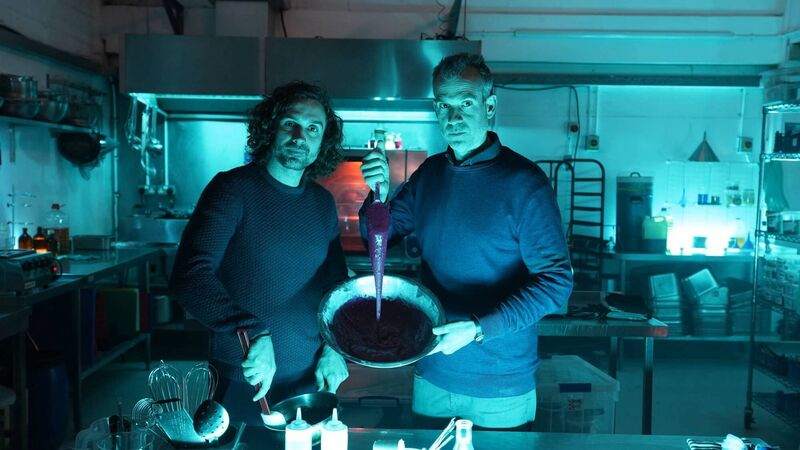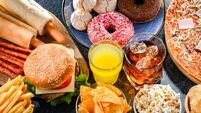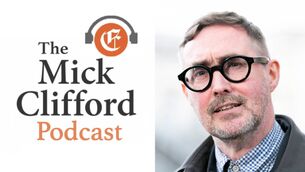Catherine Conlon: Joe Wicks's Killer Bar has achieved what no stuffy science report can do

Joe Wicks and Chris van Tulleken have developed a protein bar deliberately designed to be the 'worst possible' bar that can still legally be described as offering health benefits. Picture: KEO Films
Influencer Joe Wicks has caused a furore among nutritionists by carrying out a highly provocative stunt that he designed to convince the British government to change food laws for good.
He and Chris van Tullekan, author of Ultra-Processed People, have developed a protein bar deliberately designed to be the "worst possible" bar that can still legally be described as offering health benefits.
Nutritionists have been loud in their criticism of the campaign, suggesting there are no good or bad foods, and we should eat everything in moderation… so why are we scaring people like this? Other detractors say the campaign has gone too far when consumers are already contending with a cost-of-living crisis.
The reality is that this controversial campaign, amidst a sea of stuffy reports and evidence-based studies, may be just what we need to get people thinking about the kind of food they are consuming day after day, and the impact of that food on their bodies. The Killer campaign is highlighting just one part of a global addiction pandemic that has rocketed upwards in the last five decades.
The World Health Organization reports that one in eight people are living with obesity, with adult obesity more than doubling since 1990 while adolescent obesity has quadrupled. Added to that 2.5 billion adults are overweight and unable to control their eating.
Of course it’s not just food. The 'addiction economy' extends to smoking — 1.3 billion people smoke, with seven million people dying every year because they can’t stop. Alcohol is responsible for 2.6 million deaths every year with 400 million people suffering from problem alcohol use; while gambling is believed to cause direct harm to 600 million people.
Isn’t it time we addressed this global pandemic of addiction with more than just industry speak about everyone having a right to choose?
Joe Woof and Hillary Sutcliffe are co-leaders of the UK Addiction Economy initiative at SocietyInside — a US think tank and communications NGO, delivering research and communications tools to empower individuals and policy makers. They are attempting to challenge the right of multiple industries to fuel the addiction economy in the name of profit.
In their latest paper, they outline how, in the modern era, everyone is addicted to everything.
“Where does your brain go when you see an obese person eating a pastry in public? Or a drunk friend making a fool of themselves and passing out, yet again at a party? What about the smokers, on drips outside the hospital, still lighting up? Or the person who gambled away their savings, lost family, job, self-esteem, and yet carries on in the hope of winning it back?"
Woof and Sutcliffe suggest that the only thing that can explain spiralling global addiction is “the changing commercial environment saturated with products explicitly designed for overuse,” such that addiction is inevitable.
In terms of food alone, the industry deliberately designs food in terms of taste (unique combinations of fat, sugar and salt) and textures (crunchy on the outside, soft in the centre) to create that ‘bliss point’ that leaves us constantly wanting more.
Think of any number of products that fit this profile. The most sinful of them all — the Cadbury’s Crème Egg matches this profile exactly.
The nature of addiction means that when we consume them, the brain circuits involved in reward, motivation and self-control go into overdrive so that small cues for the product, constantly placed in front of our eyes, even subconsciously, can trigger powerful cravings, while the ability to resist them weakens.
Think of an ad for pizza before the mid-week movies — bubbling in its own addictive mess of tomato sauce and cheese with that delicious crusty base.
Even the thought is enough to put the digestive juices into overflow.
Addiction in children is an even greater risk because their immature brains are more vulnerable to these addictive products.
Advertising means that the prompts to eat junk food are literally everywhere — on phones, TV, online devices, along with prompts at sports fixtures and everywhere in between — bus stops, train stations, posters on walls, forecourts of movies — wherever the industry wants to put them except maybe schools and hospitals.
And they are almost always beautiful people — relaxing, having fun, socialising, happy families living the best life. In other words, eat this and this will be you — out there, buzzy, vibrant, laughing or tucked up with your family — bathed in a rosy, cosy glow.
The ubiquitous availability of these foods adds the final touch — addictive tastes, constant reminders to eat them and frictionless access, even at the touch of a button to the ring of the doorbell 10 minutes later — is it any wonder we are all addicted?
The food industry will use every ploy to ensure that availability is unhindered. The British Medical Journal recently reported how in the UK McDonald’s successfully challenged the majority of local council plans to help prevent childhood obesity by restricting the opening of outlets within 800m of schools. Cash-strapped councils give in to legal threats when it means saving money that is badly needed elsewhere.
And then there is Ozempic. Marketed to individuals and health systems as the solution to the huge harms and costs of obesity despite the fact that the UK’s National Institute for Health and Care Excellence (NICE) acknowledges that “there is no evidence of effectiveness if semaglutide is used as a single standalone treatment”, which it most commonly is.
The hype around the drug ignores the reality that almost everyone puts the weight back on again after the treatment ends.
The “nanny state” arguments consistently rolled out by 'Big Food' embraces the idea that the freedom to sell equates with the freedom to choose. Woof and Sutcliffe urge us to recognise that the opposite is the case.
They said:
“To do anything else will mean that mass addiction will proliferate, citizens will continue to be harmed, and health services further overwhelmed.”
Joe Wicks has shaken up the nutrition world with his Killer bars. But he has achieved what no amount of scientific evidence can do — got consumers fired up about the health impacts of food.
If the Killer Bar campaign succeeds in ensuring long overdue warning labels on ultra-processed foods and tighter regulation in the sector, then it will have succeeded where a big fat pile of stuffy science has failed.
- Catherine Conlon is a public health doctor in Cork and former director of human health and nutrition at Safefood.
















